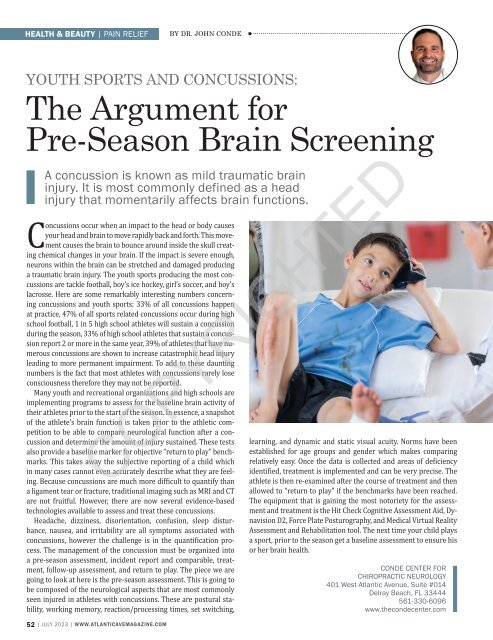Create successful ePaper yourself
Turn your PDF publications into a flip-book with our unique Google optimized e-Paper software.
health & beauty | pain relief<br />
By dr. john conde<br />
Youth Sports and Concussions:<br />
The Argument for<br />
Pre-Season Brain Screening<br />
A concussion is known as mild traumatic brain<br />
injury. It is most commonly defined as a head<br />
injury that momentarily affects brain functions.<br />
Concussions occur when an impact to the head or body causes<br />
your head and brain to move rapidly back and forth. This movement<br />
causes the brain to bounce around inside the skull creating<br />
chemical changes in your brain. If the impact is severe enough,<br />
neurons within the brain can be stretched and damaged producing<br />
a traumatic brain injury. The youth sports producing the most concussions<br />
are tackle football, boy’s ice hockey, girl’s soccer, and boy’s<br />
lacrosse. Here are some remarkably interesting numbers concerning<br />
concussions and youth sports: 33% of all concussions happen<br />
at practice, 47% of all sports related concussions occur during high<br />
school football, 1 in 5 high school athletes will sustain a concussion<br />
during the season, 33% of high school athletes that sustain a concussion<br />
report 2 or more in the same year, 39% of athletes that have numerous<br />
concussions are shown to increase catastrophic head injury<br />
leading to more permanent impairment. To add to these daunting<br />
numbers is the fact that most athletes with concussions rarely lose<br />
consciousness therefore they may not be reported.<br />
Many youth and recreational organizations and high schools are<br />
implementing programs to assess for the baseline brain activity of<br />
their athletes prior to the start of the season. In essence, a snapshot<br />
of the athlete’s brain function is taken prior to the athletic competition<br />
to be able to compare neurological function after a concussion<br />
and determine the amount of injury sustained. These tests<br />
also provide a baseline marker for objective “return to play” benchmarks.<br />
This takes away the subjective reporting of a child which<br />
in many cases cannot even accurately describe what they are feeling.<br />
Because concussions are much more difficult to quantify than<br />
a ligament tear or fracture, traditional imaging such as MRI and CT<br />
are not fruitful. However, there are now several evidence-based<br />
technologies available to assess and treat these concussions.<br />
Headache, dizziness, disorientation, confusion, sleep disturbance,<br />
nausea, and irritability are all symptoms associated with<br />
concussions, however the challenge is in the quantification process.<br />
The management of the concussion must be organized into<br />
a pre-season assessment, incident report and comparable, treatment,<br />
follow-up assessment, and return to play. The piece we are<br />
going to look at here is the pre-season assessment. This is going to<br />
be composed of the neurological aspects that are most commonly<br />
seen injured in athletes with concussions. These are postural stability,<br />
working memory, reaction/processing times, set switching,<br />
52 | <strong>July</strong> <strong>2023</strong> | www.<strong>Atlantic</strong><strong>Ave</strong><strong>Magazine</strong>.com<br />
learning, and dynamic and static visual acuity. Norms have been<br />
established for age groups and gender which makes comparing<br />
relatively easy. Once the data is collected and areas of deficiency<br />
identified, treatment is implemented and can be very precise. The<br />
athlete is then re-examined after the course of treatment and then<br />
allowed to “return to play” if the benchmarks have been reached.<br />
The equipment that is gaining the most notoriety for the assessment<br />
and treatment is the Hit Check Cognitive Assessment Aid, Dynavision<br />
D2, Force Plate Posturography, and Medical Virtual Reality<br />
Assessment and Rehabilitation tool. The next time your child plays<br />
a sport, prior to the season get a baseline assessment to ensure his<br />
or her brain health.<br />
COPYRIGHTED<br />
Conde Center For<br />
ChiroPRACTIC Neurology<br />
401 West <strong>Atlantic</strong> <strong>Ave</strong>nue, Suite #014<br />
Delray Beach, FL 33444<br />
561-330-6096<br />
www.thecondecenter.com

















